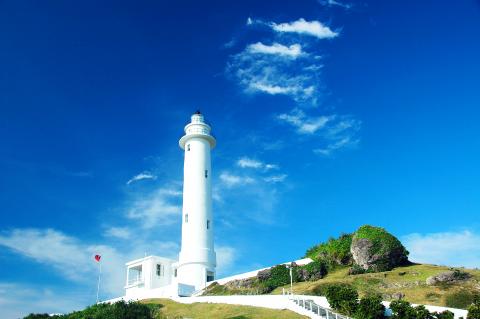Two more lighthouses will be opened to tourists later this year, the Maritime and Port Bureau said yesterday.
The bureau, an agency of the Ministry of Transportation and Communications, took over responsibility for the nation’s lighthouses and navigation aids last month from the Customs Administration, which had been building and managing lighthouses since 1863, first in China and then in Taiwan.
Michael Liang (梁瑞聰), a division director at the bureau, said there are a total of 34 lighthouses, 44 light posts and 14 radar beacons nationwide, including those on Penghu, Kinmen and Matsu.

Photo courtesy of the Maritime and Port Bureau
Only six are open to the public — the ones in Yuwongdao (漁翁島) in Penghu County, Dongjudao (東莒島) and Dongyin Island in Lienchiang County (Matsu), Greater Kaohsiung, Cape San Diego (三貂角) and Oluanpi (鵝鑾鼻).
The bureau is planning to open the Baishachia (白沙岬) Lighthouse in Taoyuan County and Green Island (綠島) Lighthouse to visitors in September, Liang said.
The Baishachia Lighthouse, which has been in operation since 1898, has been designated a historic monument by the Taoyuan County Government, the bureau said, while the Green Island Lighthouse, which went into service in 1939, has been designated a historic building in Taitung County.
Although the functions of a lighthouse have largely been replaced by global positioning systems (GPS), the structures are part of the nation’s cultural heritage and have long histories,such as the one in Yuwongdao (漁翁島), which has been in use since 1778, Liang said. Aside from seeing the old-fashioned lighthouse equipment, visitors to the Yuwongdao site would be able to visit an old graveyard for foreigners nearby, he said.
Nine of the 34 lighthouses have been designated historic buildings or monuments, either by the central government or a city or county government, and five of the nine are open to visitors.
The Wuciou (烏坵) Lighthouse in Kinmen County and Mudouyu (目斗嶼) Lighthouse in Penghu County, both listed historic buildings, are unlikely to be opened for tourists, he said.
“There is no regular boat service to Mudouyu and the Wuciou site is still guarded by the military,” he said.
Earlier this week, Minister of Transportation and Communications Mao Chi-kuo (毛治國) said now that the ministry is responsible for the lighthouses, it would emphasize their tourism value.
The Tourism Bureau said that it would work with the Maritime and Port Bureau to boost the tourism potential of the lighthouses by making lighthouse tours a selling point at festivals and other events organized by its national scenic administrations and other government or non-government organizations.
Tourism Bureau officials cited a travel plan proposed by a participant in last year’s Taiwan Cycling Festival, who visited the northernmost, southernmost, easternmost and westernmost lighthouses in Taiwan proper in just two days by using the railways, the MRT and bicycles.
According to Green Island Township Office, the lighthouse on the island was built after the USS President Hoover ran aground on a reef off the island’s coast on Dec. 11, 1937, while sailing from Japan to the Philippines.
The American Red Cross funded the lighthouse as a thank-you to the islanders who had rescued the passengers and crew of the Hoover.
The lighthouse was destroyed during a World War II air strike and rebuilt by the Chinese Nationalist Party (KMT) government in 1948.
Additional reporting by Staff writer

US climber Alex Honnold is to attempt to scale Taipei 101 without a rope and harness in a live Netflix special on Jan. 24, the streaming platform announced on Wednesday. Accounting for the time difference, the two-hour broadcast of Honnold’s climb, called Skyscraper Live, is to air on Jan. 23 in the US, Netflix said in a statement. Honnold, 40, was the first person ever to free solo climb the 900m El Capitan rock formation in Yosemite National Park — a feat that was recorded and later made into the 2018 documentary film Free Solo. Netflix previewed Skyscraper Live in October, after videos

Starting on Jan. 1, YouBike riders must have insurance to use the service, and a six-month trial of NT$5 coupons under certain conditions would be implemented to balance bike shortages, a joint statement from transportation departments across Taipei, New Taipei City and Taoyuan announced yesterday. The rental bike system operator said that coupons would be offered to riders to rent bikes from full stations, for riders who take out an electric-assisted bike from a full station, and for riders who return a bike to an empty station. All riders with YouBike accounts are automatically eligible for the program, and each membership account

NUMBERS IMBALANCE: More than 4 million Taiwanese have visited China this year, while only about half a million Chinese have visited here Beijing has yet to respond to Taiwan’s requests for negotiation over matters related to the recovery of cross-strait tourism, the Tourism Administration said yesterday. Taiwan’s tourism authority issued the statement after Chinese-language daily the China Times reported yesterday that the government’s policy of banning group tours to China does not stop Taiwanese from visiting the country. As of October, more than 4.2 million had traveled to China this year, exceeding last year. Beijing estimated the number of Taiwanese tourists in China could reach 4.5 million this year. By contrast, only 500,000 Chinese tourists are expected in Taiwan, the report said. The report

Temperatures are forecast to drop steadily as a continental cold air mass moves across Taiwan, with some areas also likely to see heavy rainfall, the Central Weather Administration (CWA) said. From today through early tomorrow, a cold air mass would keep temperatures low across central and northern Taiwan, and the eastern half of Taiwan proper, with isolated brief showers forecast along Keelung’s north coast, Taipei and New Taipei City’s mountainous areas and eastern Taiwan, it said. Lows of 11°C to 15°C are forecast in central and northern Taiwan, Yilan County, and the outlying Kinmen and Lienchiang (Matsu) counties, and 14°C to 17°C